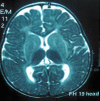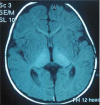GM2-Gangliosidosis (Sandhoff and Tay Sachs disease): Diagnosis and Neuroimaging Findings (An Iranian Pediatric Case Series)
- PMID: 25143775
- PMCID: PMC4135282
GM2-Gangliosidosis (Sandhoff and Tay Sachs disease): Diagnosis and Neuroimaging Findings (An Iranian Pediatric Case Series)
Abstract
Objective: GM2-Gangliosidosis disease is a rare autosomal recessive genetic disorder that includes two disorders (Tay-Sachs and Sandhoff disease).These disorders cause a progressive deterioration of nerve cells and inherited deficiency in creating hexosaminidases A, B, and AB.
Materials & methods: Patients who were diagnosed withGM2-Gangliosidosis in the Neurology Department of Mofid Children's Hospital in Tehran, Iran from October 2009 to February 2014were included in our study. The disorder was confirmed by neurometabolic and enzyme level detection of hexosaminidases A, B, and AB in reference to Wagnester Laboratory in Germany. We assessed age, gender, past medical history, developmental status, clinical manifestations, and neuroimaging findings of 9 patients with Sandhoff disease and 9 with Tay Sachs disease.
Results: 83% of our patients were the offspring of consanguineous marriages. All of them had a developmental disorder as a chief complaint. 38%of patients had a history of developmental delay or regression and 22% had seizures. The patients with Sandhoff and Tay Sachs disease were followed for approximately 5 years and the follow-up showed all patients were bedridden or had expired due to refractory seizures, pneumonia aspiration, or swallowing disorders. Neuro-imaging findings included bilateral thalamic involvement, brain atrophy, and hypo myelination in near half of our patients (48%).
Conclusion: According to the results of this study, we suggest that cherry-red spots, hyperacusis, refractory seizures, and relative parents in children with developmental delay and/or regression should be considered for assessment of GM2-Gangliosidosis disease.
Keywords: Genetic disorders; Neurometabolic disorders; Sandhoff disease; Tay Sachs disease.
Figures




References
-
- Yun YM, Lee SN. A case refort of Sandhoff disease. Korean journal of ophthalmology: KJO. 2005;19(1):68–72. Epub 2005/06/03. - PubMed
-
- O’Dowd BF, Klavins MH, Willard HF, Gravel R, Lowden JA, Mahuran DJ. Molecular heterogeneity in the infantile and juvenile forms of Sandhoff disease (O-variant GM2 gangliosidosis) The Journal of biological chemistry. 1986;261(27):12680–5. Epub 1986/09/25. - PubMed
-
- Cashman NR, Antel JP, Hancock LW, Dawson G, Horwitz AL, Johnson WG, et al. N-acetyl-beta-hexosaminidase beta locus defect and juvenile motor neuron disease: a case study. Annals of neurology. 1986;19(6):568–72. Epub 1986/06/01. - PubMed
-
- Oonk JGW, Van der Helm HJ, Martin JJ. Spinocerebellar degeneration: hexosaminidase A and B deficiency in two adult sisters. Neurology. 1979;29:380–384. - PubMed
LinkOut - more resources
Full Text Sources
Other Literature Sources
Miscellaneous
